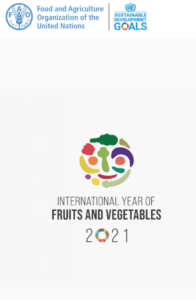Welcome to Phytogen for 2021.
On the 20th of January 2021, I talked with Dr Peter Ryan, the recently appointed President of ASPS. I thought you will enjoy reading a brief snapshot of his career and pathway to the Presidency. I’ve also asked him to provide some photos and references to complement the story.
I first heard Peter’s name in the 1990s when he was a frequent visitor to Adelaide to collaborate with my PhD supervisor Professor Steve Tyerman. Peter was investigating the mechanisms of aluminium tolerance in plants at the time and had a hunch that the major gene controlling this trait in wheat encoded an anion channel. He was keen to test this idea in Steve’s lab by applying electrophysiological techniques to measure membrane transport processes. But more of this later.
A career by the ocean please!
The first thing I learnt is that Peter did not start out as a “plant person”. He grew up in the small NSW town of Forbes and his family visited the Central Coast for holidays – around Woy Woy and the Entrance. The ocean instantly captivated him. The family later moved to Avoca Beach and although he boarded at Hurlstone Agricultural High School in Sydney he spent all his holidays at Avoca swimming, snorkelling and diving. It was inevitable that his undergraduate degree at Sydney University would be in zoology and marine biology. The degree included only a single semester on marine algae and he blames this lack of classical botanical training for his embarrassing lack of taxonomy (although he’s still handy on an intertidal rock platform). Peter envisaged a career connected with the ocean and animals in some way so the fact that he ended up spending most of his research life studying wheat in Canberra still puzzles him.
Peter’s “marine dream” probably started going pear-shaped when he chose to do honours with Ros Hinde on nutrient uptake and temperature stress in the marine algae Codium fragile (also known as dead man’s fingers). This led to a PhD with N (Alan) Walker, also at Sydney University, looking at nitrogen uptake by the brackish algae Chara australis. With its giant coenocytic cells, Chara was a model system for membrane transport studies and the darling of electrophysiologists around the world. Most Australian pioneers in plant membrane transport had large tanks of Chara or Nitella growing in their labs. Those notables included Alex Hope, Geoff Findlay, F (Andrew) Smith, Rob Reid, Steve Tyerman and Mary Beilby as well as Alan. Peter claims to have had a steep learning curve during his PhD but was excited by his early forays into real research. He quickly admitted, however, that the publications to emerge from his PhD did not change the world. The first paper (Ryan and Walker 1993) has been cited a total of four times during the last 28 years: Peter is responsible for one of these, another appears in an obituary for his supervisor, a third was included a comprehensive review of Characean research, and the fourth was likely a mistake. The other papers fared a little better.
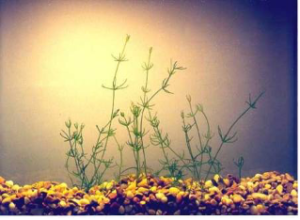
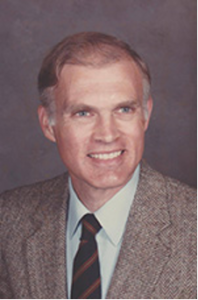
Chara australis growing in a tank.
Vale Thomas B Kinraide
(USDA West Virginia)
(1942-2020).
A terrific scientist and good friend in Ithaca.
Best laid plans slip away with post-docs in Tasmania and the USA
Peter completed a post-doc with Ian Newman in the physics department at the University of Tasmania in 1989 looking at nutrient fluxes along Chara cells and maize roots using the recently invented microelectrode ion flux estimation (MIFE) technique. He enjoyed his time in Tassie very much and even bought a small block of land south of Hobart for $12,000 hoping that he would get further work or perhaps retire there later. Instead, he applied for a CSIRO Travelling Scholarship and, on the encouragement of Peter Randall at CSIRO, joined Leon Kochian’s lab at the USDA lab on the stunningly beautiful Cornell University campus in Ithaca NY, USA. This is where Peter began working on the mechanisms of aluminium toxicity and tolerance in plants. Aluminium toxicity is the major cause of yield losses on acid soils in Australia (~$1 billion pa) because, as soil pH falls, the concentration of the highly toxic trivalent aluminium (Al3+) ion increases in the soil solution. Micromolar concentrations can inhibit the root growth of many important crops. Australia has large areas of acidic soils in the south-east growing zones and in Western Australia and the pH of some highly productive regions alarmingly continues to decrease. Germplasm improvement and lime application are the main management options available to growers.
Additional funding from the USDA and Cornell allowed Peter to extend his time with the USDA to almost three years. During that time, he was lucky enough to meet and work with other exceptional scientists including Leon, Tom Kinraide and Tony Glass. It was during Tom Kinraide’s short sabbatical at Leon’s lab that they began to discuss the fixed charges on the cell membranes and cell walls and how charge density would influence the perceived toxicity of multivalent ions such as aluminium (Kinraide and Ryan 1991; Kinraide et al., 1992). It was an immensely interesting and productive collaboration for Peter. Sadly Tom Kinraide passed away last year.
Peter recalls that of the papers published from that time in Ithaca, the one with the greatest number of citations came from the simplest of studies. It examined the spatial aspects of aluminium toxicity on maize roots and demonstrated that exposing aluminium to just the apical few millimetres of root was sufficient to inhibit growth (Ryan et al., 1993). If all the root was exposed to Al3+ except for that small region, growth was similar to the Al3+-free controls. This confirmed that direct interactions between aluminium and cells at the root tip were required to inhibit growth. Peter was very grateful for the opportunities provided by that wonderful scholarship which, he regrets, are no longer available. During that time at Cornell he also met his future wife Becky.
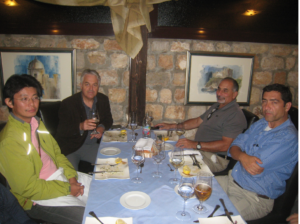
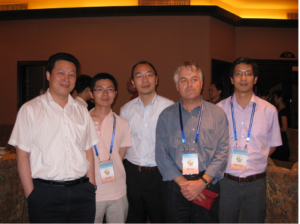
Catching up many years later at a workshop in Dubrovnik 2015. Shown are Naoki Yamaji, Peter Ryan, Leon Kochian and Miguel Pineros.
Members of the international steering committee for symposia on plant-soil responses to low pH. Shown are Renfeng Shen, Jianli Yang, Jian Feng Ma, Peter and Jian Shao Zheng at a symposium in Guangzhou 2009.
Returning to CSIRO
Peter returned to Canberra in 1993 and began working in related areas in the Black Mountain labs with Manny Delhaize and Peter Randall. I found it interesting hearing how their work on Al3+ tolerance developed over the years. Manny had joined CSIRO two or three years earlier than Peter after returning from his own Travelling Scholarship to Los Alamos, USA. During that time, he had obtained a segregating population of wheat varying in Al3+ tolerance from Brendan Scott at the NSW DPI and found that the roots of tolerant genotypes accumulated less aluminium and released more malate than sensitive genotypes. The genetics suggested a single major gene was responsible. Once Peter joined the team they established that the malate release only occurred from the root apices and gathered patch-clamping evidence that anion channels were involved (Delhaize et al., 1993; Ryan et al., 1995; Ryan et al., 1997; Zhang et al., 2001). Their model proposed that the malate released from roots protects the sensitive root tips by binding with aluminium to form less harmful complexes. This was the first mechanism for aluminium tolerance in plants that was supported by physiology and genetics. Soon after its publication many other groups began to report similar mechanisms operating in other monocots and eudicots (Ma et al., 2001; Ryan et al., 2001). However, identifying the gene controlling aluminium tolerance in wheat remained their main goal.
Peter explained that the 1990s was an exciting period in acid soil research for other reasons because, in Japan, Professors Hideaki Matsumoto and Yoko Yamamoto from Okayama University secured a generous grant to study acid soil stress in crops. This enabled them to recruit many enthusiastic students and post-docs and to sponsor a series of focused workshops on the subject. Regular attendees to these workshops included Walter Horst, Leon Kochian, Tadao Wagatsuma, Hiroyuki Koyama, Zed Rengel and many outstanding early career researchers. The latter included Jian Feng Ma, Takayuki Sasaki, Miguel Pinēros and Shao Jian Zheng just to name a few, all of whom have made substantial contributions to the field.
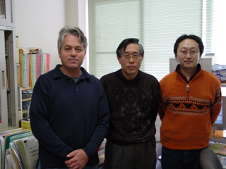
Visiting collaborators Hideaki Matsumoto and Takayuki Sasaki at Okayama University in the mid 1990s.
Genes, genes and more genes
It finally happened. Eleven years after the mechanism for Al3+ tolerance in wheat was first proposed, a team from CSIRO and Okayama University finally published the gene (Sasaki et al 2004). They named it the aluminium-activated malate transporter (TaALMT1). Turns out that TaALMT1 did encode an anion channel as Peter predicted – in fact it was the first member of a novel family of anion channels. Members of the ALMT1 family are now known to be widespread in plants where they perform an array of different functions in different tissues – mostly unrelated to Al3+ tolerance. For example, it is now clear that some ALMTs encode the rapid anion channels (R type/QUAC) identified years earlier by electrophysiologists in guard cells (Roelfsema and Hedrich, 2012). Many ALMTs are also permeable to γ amino butyric acid (Ramesh et al., 2018) and therefore may act as important signalling receptors. An individual ALMT can even perform multiple roles in the same plant plant (Xu et al., 2015). Peter believes this fascinating family of channels has many more surprises to reveal.
A few years later, the team identified a second mechanism of Al3+ tolerance in wheat which relies on the release of citrate from the root apices instead of malate. The gene controlling this second mechanism was identified and named TaMATE1B. It also encodes a transporter protein but from the multidrug and toxic compound exudation (MATE) family (Ryan et al 2009; Tovkach et al. 2013). It soon became clear from mutational studies in rice and Arabidopsis that other mechanisms of Al3+ tolerance, independent of organic anions, were also operating in plants, sometimes in parallel. These findings provided novel opportunities for improving the acid-soil tolerance of important crop species either through conventional breeding or through biotechnology (Delhaize et al., 2004; Ryan and Delhaize 2010; Ryan et al 2011).
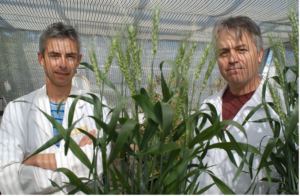
Manny Delhaize and Peter Ryan in a glasshouse at CSIRO Black Mountain laboratories.
Peter’s other research interests have revolved around roots and nutrition. He recently enjoyed interacting with John Passioura and Andrey Carminatti looking at water uptake, and with Evans Lagudah, Ricky Milne and Kathy Dibley at CSIRO investigating adult plant resistance to diseases. Peter also began working with soil microbiologist Akitomo Kawasaki, Michelle Watt and others to examine how the microbiome around roots can be engineered by manipulating root exudates (Kawasaki et al 2016, Kawasaki et al 2021). Peter explained that there is increasing interest in methods to manipulate the rhizosphere in order to encourage the persistence of beneficial microorganisms around roots. This approach could provide low-input options for improving plant nutrition, increasing weed competitiveness and minimising root diseases.
Lifting the gaze from the bench
Now as ASPS President, Peter is considering other issues. He is particularly concerned about the falling enrolments in plant biology and agriculture at universities, two disciplines that need to be boosted if countries are to meet the challenges presented by a growing world population. He reminds me that agriculturalists face the task of growing ~50% more food over the next 30 years using the same area of land and doing so in a sustainable manner. He offers two factors that may explain the disappointing enrolments in plant sciences. The first is the quality of science education at the primary and secondary levels. Figures quoted by the Office of the Chief Scientist a few years ago revealed that 26% of teachers at Years 7–10 and about 15% of teachers at Years 11–12 are teaching subjects they have not specialised in (https://research.acer.edu.au/cgi/viewcontent.cgi?article=1005&context=policyinsights). He suggests that everyone should be astonished by these stats – we can hardly expect students to be enthused or excited by subjects that their own teachers may be struggling to fully grasp themselves. Teachers are critical to our communities but as a society he believes we undervalue them and underpay them. The second factor in declining enrolments is the precarious career paths faced by early career researchers – a serious deterrent. We can forgive students for hesitating to choose a future in plant science when too many of them complete their first or second post-docs only to find they are unable to win further research grants or secure one of the few jobs in academia. Peter joins the chorus of discontent in these areas but hopes to work with other organisations, such as Science and Technology Australia, to develop policy alternatives to parliamentarians and decision makers.
The conversation inevitably drifted to Covid 19 and it was here that Peter expressed some final points. He recognised the terrible disruption Covid caused research in 2020 by restrictions to movement and resources but was quick to emphasise some positive outcomes for science. When governments around the world were faced with this crisis, some quickly sought expert advice while others ignored it. Those countries that did not seek advice, or did so too slowly, suffered more and incurred many more deaths than the countries that responded rapidly. This correlation became obvious to anyone in the world with a TV or radio and he argues that it helped science regain some standing in the community, highlighting the value of facts and reason over conjecture and self-interest. Peter asserts that this change catalysed an important reversal from the anti-science mindset and “alternative facts” that have plagued the climate debate. Peter despairs at the lack of urgency about climate change and hopes that we can ride this tide of change to convince governments that more ambitious climate policies are required to reduce carbon emissions.
Finally, Peter suggests that a second positive outcome emerging from Covid was providing a perfect example of how research funding leads directly to innovation and national benefit. In less than a year, a handful of effective vaccines against Covid 19 have been conceived, developed, tested and produced on a global scale ready for distribution. This was an extraordinary feat, especially considering that it was not even clear that effective vaccines to coronaviruses were possible. Although the vaccine generated here in Australia by the University of Queensland was not continued, the innovative “molecular clamp” platform technologies they used will surely be useful in the future. Peter emphasises that science funding should never be discretionary or an optional extra that is traded from budget to budget. Instead it should be an essential part of how we prepare for the future.
Delhaize, E., Ryan, P.R. and Randall, P.J. (1993) Aluminum tolerance in wheat (Triticum aestivum L.) II Aluminum stimulated excretion of malic acid from root apices. Plant Physiology, 103: 695-702.
Delhaize E, Ryan PR, Hebb DM, Yamamoto Y, Sasaki T, Matsumoto H. (2004) Engineering high-level aluminum tolerance in barley with the ALMT1 gene. Proceedings of the National Academy of Sciences, USA. 101, 15249-54
Kawasaki A, Dennis PG, Forstner C, Raghavendra AKH, Richardson AE, Watt M, Mathesius U, Gilliham M and Ryan PR (2021) The microbiome of wheat and rice roots exhibits significant differences in structure between root types and along root axes. Function Plant Biology (in press).
Kawasaki A, Donn S, Ryan PR, Mathesius U, Devilla R, Jones A, Watt M (2016) Microbiome and exudates of the root and rhizosphere of Brachypodium distachyon, a model for wheat. PLOS One 11, e0164533
Kinraide, T.B., and Ryan, P.R. (1991) Cell surface charge may obscure the identity of the rhizotoxic Al species. Current Topics in Plant Biochemistry and Physiology, 10: 117-133.
Kinraide, T.B., Ryan, P.R., and Kochian, L.V. (1992) Interactive effects of Al3+, H+ and other cations on root elongation considered in terms of cell-surface electrical potential. Plant Physiology, 99: 1461-1468.
Ma JF, Ryan PR, Delhaize E (2001) Aluminium tolerance in plants and the complexing role of organic acids. Trends in Plant Science 6, 273-278
Ramesh S, Tyerman SD, Xu B, Bose J, Kaur S, Conn V, Domingos P, Ullah S, Wege S, Shabala S, Feijó J, Ryan PR, Gilliham M (2015) GABA signalling modulates plant growth by directly regulating the activity of plant-specific anion transporters. Nature CommunicationsDOI: 10.1038ncomms8879
Roelfsema MRG, Hedrich R (2012) Anion channels: master switches of stress responses, Trends in Plant Science 17, 221-229
Ryan PR, Delhaize E (2010) The convergent evolution of aluminium resistance in plants exploits a convenient currency. Functional Plant Biology 37, 275-284
Ryan, P.R., Delhaize, E., Jones, D.L. (2001) Function and mechanism of organic anion exudation from plant roots. Annual Review of Plant Physiology and Plant Molecular Biology 52, 527-560
Ryan, P.R., Delhaize, E., Randall, P.J. (1995) Characterisation of Al-stimulated efflux of malate from the apices of Al-tolerant wheat roots. Planta, 196: 103-111.
Ryan, P.R., DiTomaso, J.M. and Kochian, L.V. (1993) Aluminum toxicity in roots: Investigation of spatial sensitivity and the role of the root cap. Journal of Experimental Botany, 44: 437-446.
Ryan PR, Raman H, Gupta S, Horst W Delhaize E (2009) A second mechanism for aluminum resistance in wheat maps to chromosome 4BL and relies on constitutive efflux of citrate from roots. Plant Physiology 149, 340-351
Ryan, P.R., Skerrett, M., Flindlay, G., Delhaize, E., Tyerman, S.D. (1997) Aluminium activates an anion channel in the apical cells of wheat roots. Proceedings of the National Academy of Sciences, USA, 94: 6547-6552
Ryan PR, Tyerman SD, Sasaki T, Yamamoto Y, Zhang WH, Delhaize E (2011) Identification of aluminium-resistance genes in plants provides an opportunity for enhancing the acid-soil tolerance of crop species. Journal of Experimental Botany 62, 9-20
Ryan, P.R. and Walker, N.A. (1993). Accumulation of malate in the vacuoles of Chara australis during the uptake of ammonium from chloride-free solution. Journal of Experimental Botany, 44: 637-643.
Sasaki T, Yamamoto Y, Ezaki B, Katsuhara M, Ahn SJ, Ryan PR, Delhaize E, Matsumoto H (2004) A wheat gene encoding an aluminum-activated malate transporter. Plant Journal 37, 645-653
Tovkach A, Ryan PR, Richardson AE, Lewis D, Rathjen TM, Ramesh S, Tyerman SD, Delhaize E (2013) Transposon-mediated alteration of TaMATE1B expression in wheat roots confers constitutive citrate efflux from root apices. Plant Physiology 161, 880-892
Xu M, Gruber BD, Delhaize E, James RA, White RG, You JF, Yang ZM, Ryan PR (2015) The barley anion channel, HvALMT1, has multiple roles in guard-cell physiology and grain metabolism Physiologia Plantarum 153: 183–193. 2015
Zhang W-H, Ryan PR, Tyerman SD (2001). Malate-permeable channels and cation channels activated by aluminum in the apical cells of wheat roots. Plant Physiology 125, 1459-1472
The FAO (Food and Agriculture Organisation of the United Nations) has declared 2021 as UN’s International Year of Fruits and Vegetables. There is an innovation award due March 19th 2021.
 |
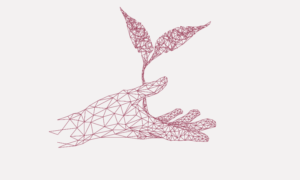 |

